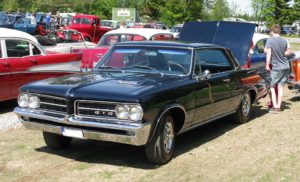A Small History Behind A Big Car – Muscle Car
by: Gerry Askew

1964 Pontiac GTO image By Herranderssvensson (Own work) [CC BY-SA 3.0 (http://creativecommons.org/licenses/by-sa/3.0)], via Wikimedia Commons
Almost every historian and car buff credits Pontiac with the first “muscle car” on the market, which was a variation on the Tempest, the 1964 GTO. This first muscle car offered a huge V-8 engine that boasted 389 cubic inches and a floor-shift manual transmission instead of on the column. With a newer, sleek look and trim inside and out that was to die for, who could resist the car that was born that year. These cars sold like hotcakes, even though Pontiac was in direct violation of a General Motors policy on the size of the engines that are placed in their vehicles. It didn’t matter, the muscle car was born, and everyone rushed to get in on the action.

1965 Pontiac GTO Hardtop image By Sicnag (1965 Pontiac GTO Hardtop) [CC BY 2.0 (http://creativecommons.org/licenses/by/2.0)], via Wikimedia Commons
Though they were wildly popular, the muscle car didn’t quite sell as many as their manufacturers would have liked, but their rise in popularity has not been matched since. No other type of car in history has been able to create such an air of personality as the muscle car has. But, toward the mid 1970’s, these smaller, budget muscle cars once again got a boost. The competition in the auto industry was heating up once more, and the muscle cars produced during this time boasted some of the biggest engines ever thought of, like the 450 big block. Although this created yet another spike in sales and popularity, concerns about the safety of these cars gave way to more protests and problems. With some of the other industries, like the insurance agencies, protesting the larger muscle cars and refusing to insure them, the sales of these powerful icons plummeted. Then, another crushing blow to the muscle car, the oil problems that plagued the world in the late 70’s and early 80’s ended the muscle car altogether, and auto manufacturers removed them completely from the market.

’67 Pontiac GTO Coupe image By Bull-Doser (Own work.) [Public domain], via Wikimedia Commons
Author: Gerry Askew is an experienced webmaster and publisher. For more information check out – http://musclecars.informationvalet.com
| About The Author
Gerry Askew is an experienced webmaster and publisher. For more information check out – http://musclecars.informationvalet.com. |
Article Source: Article City
Muscle Cars for Sale
Part of the reason Classic Cars Online US exists is to help connect classic car buyers and sellers, and we’ve added several ways for you to connect, but first, be sure to visit the Classifieds page if you’re in the market to buy or sell muscle cars.
To be the first to know about our site updates and latest offerings, sign up for the newsletter on the upper right side of this page.
If you would like to connect on social media, be sure to visit and like this site’s Facebook page, the Best Classic Cars for Sale Online Facebook page or join the Classic Cars Online: Classic Cars for Sale Facebook group.
